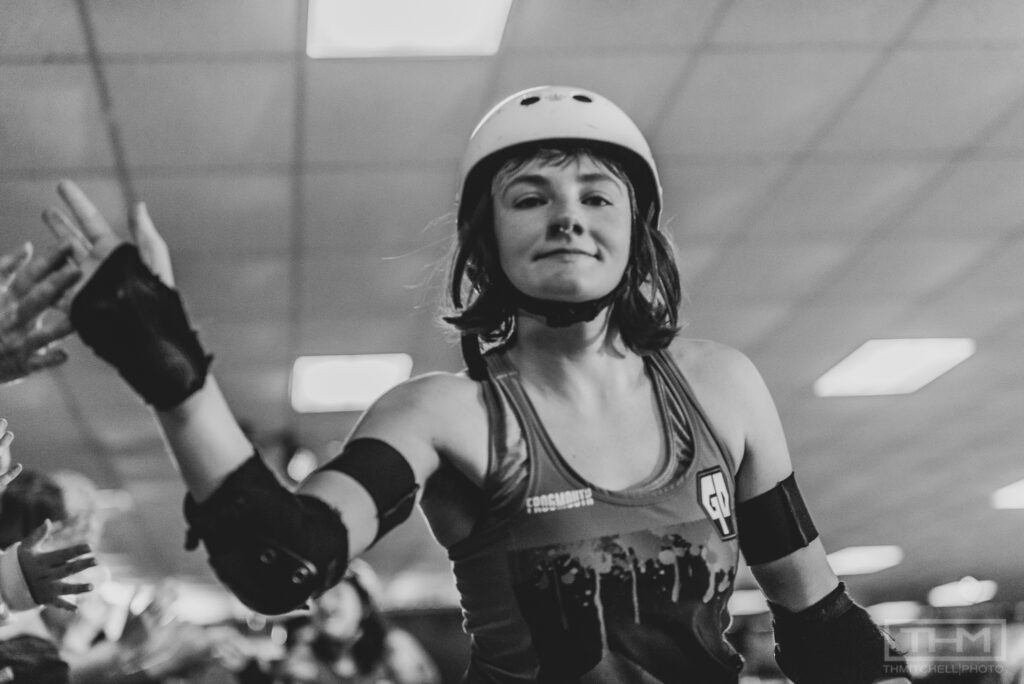By Jane Valencia
Roller derby practice is tonight. After a full day as a mom, Alice Watson drops off her three-year-old son Sorrel with her co-parent Caelan at the tail end of his work day. Then she rushes off to the ferry with a drive to north Seattle on the other side, a 1½ hour commute. Off Highway 99, Alice arrives at a warehouse that serves as the team’s practice space.
There’s no heat in the building, and water drips from the ceiling. As Alice and her teammates shed layers and pull on shorts and gear, chit-chat ensues – “How was your day? How are your kids?” – along with good-natured grumbling about how very cold it is. Alice warms up with a few laps with stops, joins in with the group warm ups, and the two-hour practice begins.
As always, it feels great to be back on skates, and to feel the exhilaration and camaraderie as play begins. At the end, Alice will take a 10:35 p.m. ferry home, catching up on the needs of life by using her phone during the hour-long wait in the car. The next morning, she’s up at 6:00 a.m. to get ready for work and help her son get ready for preschool.
What is it about roller derby that takes Alice, a young mom, off the Island three times a week, to play on both the Rat City Roller Derby home team, “Grave Danger,” and Rat City’s traveling All Stars team? And just what is roller derby anyway?
Roller derby is a full-contact sport. “But,” Alice explains, “this doesn’t mean you can throw elbows or hit people – you can’t do that. It’s all-body contact and blocking. You’re blocking with your hips and your shoulders.”
In a nutshell, the game, called a “bout,” involves two teams of five, each with a jammer, three blockers, and a pivot, who can turn from blocker to jammer under certain circumstances. Blockers put their bodies together, creating walls, and do hip checks, shoulder hits, and more, to keep the opposing jammer from making their way through the pack, and to help their own jammer get through. The jammer scores points when breaking through the blockers. The action takes place in fast-paced two-minute “jams.”
Alice was 13 when she got into roller derby. “I was in a lot of trouble all the time,” she shared. As Alice skated weekly at the local rink, her mom suggested she try roller derby.
“And so I tried it out. I was already pretty comfortable on skates, so that helped. I really took to it, and it changed a lot of things for me, too. It brought me closer to my family. It gave me an outlet and something to focus on.”
Alice joined a team with the I-5 Rollergirls, a junior multi-level league based out of Seattle, and played with the league for five years. The league collapsed a year or so after she aged out at 18. Six years later, having attended college and become a mom, she joined Rat City Roller Derby.
Alice started out as a jammer on the B team with I-5 Rollergirls, and became a blocker with the A team. She is a blocker with Rat City. I had to ask about injuries. She ends up with bruises, but with the adrenaline and all that’s happening during the course of play, doesn’t tend to feel them. She did crack her ribs last autumn.
What’s it like to play?
“I guess it’s what people kind of describe as a flow state. That’s when you don’t think about anything else. For me, I’m really laser-focused on one person and just doing anything that I can. And then you are also thinking about your jammer and potentially helping them get through.”
But, for Alice, roller derby expands beyond the sport. “You are really in it, not just in the game.” Upon joining the league, Alice found that she had access to that community right away, and friends. “We all are super-connected outside of the sport, too. So, beyond even love for playing the game is love for the greater community.”
Alice explains further. “The league is very close-knit, and very tied in with activism and the greater community, too. It’s is a subculture as much as it is a sport. There’s not a specific age or gender or body that plays roller derby. We come from all different backgrounds and experiences with sports. Derby has the ability to show us that all we are athletic, strong, and a valuable part of a team.”
Teaching related to diversity, equity, and inclusion, as well as healing, are a core part of league meetings. “We have a long way to go, as does every organization,” she says, “but are continuously in discussion about equity, inclusion, and how we can stick to our values.”
Alice also mentions, “I think it’s really cool that we have players from all ages and backgrounds, we have teachers and bus drivers, doctors and lawyers. You know people by their derby name and see them in their skate clothes, and then you talk to them outside of derby, or run into them, and discover that they are a lawyer, or have four kids.”
”There are lots of parents,” Alice notes, “and just such an array of people that aren’t always included in sports.“
Find out more!
Attend a bout: Saturday, November 18, 5:30 pm – Rat City All Star Program Expo Bout Mash-up. At the Southgate Roller Rink, 9646 17th Avenue SW, Seattle, WA 98106.
Join the sport: Rat City has three training programs, offering opportunities for complete beginners through experienced skaters seeking to be drafted on one of the four home teams.
Support: Opportunities abound to support the league as a fan or a business.
See ratcityrollerderby.com for information about any of the above.

